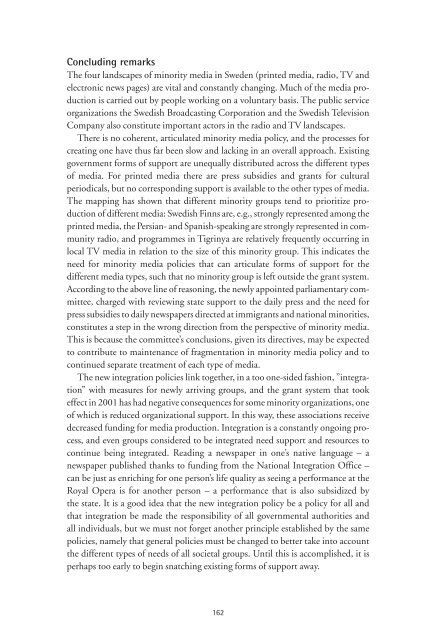Minoritetsmedier och minoritetsmediepolitik i Sverige - Myndigheten ...
Minoritetsmedier och minoritetsmediepolitik i Sverige - Myndigheten ...
Minoritetsmedier och minoritetsmediepolitik i Sverige - Myndigheten ...
Create successful ePaper yourself
Turn your PDF publications into a flip-book with our unique Google optimized e-Paper software.
Concluding remarks<br />
The four landscapes of minority media in Sweden (printed media, radio, TV and<br />
electronic news pages) are vital and constantly changing. Much of the media production<br />
is carried out by people working on a voluntary basis. The public service<br />
organizations the Swedish Broadcasting Corporation and the Swedish Television<br />
Company also constitute important actors in the radio and TV landscapes.<br />
There is no coherent, articulated minority media policy, and the processes for<br />
creating one have thus far been slow and lacking in an overall approach. Existing<br />
government forms of support are unequally distributed across the different types<br />
of media. For printed media there are press subsidies and grants for cultural<br />
periodicals, but no corresponding support is available to the other types of media.<br />
The mapping has shown that different minority groups tend to prioritize production<br />
of different media: Swedish Finns are, e.g., strongly represented among the<br />
printed media, the Persian- and Spanish-speaking are strongly represented in community<br />
radio, and programmes in Tigrinya are relatively frequently occurring in<br />
local TV media in relation to the size of this minority group. This indicates the<br />
need for minority media policies that can articulate forms of support for the<br />
different media types, such that no minority group is left outside the grant system.<br />
According to the above line of reasoning, the newly appointed parliamentary committee,<br />
charged with reviewing state support to the daily press and the need for<br />
press subsidies to daily newspapers directed at immigrants and national minorities,<br />
constitutes a step in the wrong direction from the perspective of minority media.<br />
This is because the committee’s conclusions, given its directives, may be expected<br />
to contribute to maintenance of fragmentation in minority media policy and to<br />
continued separate treatment of each type of media.<br />
The new integration policies link together, in a too one-sided fashion, ”integration”<br />
with measures for newly arriving groups, and the grant system that took<br />
effect in 2001 has had negative consequences for some minority organizations, one<br />
of which is reduced organizational support. In this way, these associations receive<br />
decreased funding for media production. Integration is a constantly ongoing process,<br />
and even groups considered to be integrated need support and resources to<br />
continue being integrated. Reading a newspaper in one’s native language – a<br />
newspaper published thanks to funding from the National Integration Office –<br />
can be just as enriching for one person’s life quality as seeing a performance at the<br />
Royal Opera is for another person – a performance that is also subsidized by<br />
the state. It is a good idea that the new integration policy be a policy for all and<br />
that integration be made the responsibility of all governmental authorities and<br />
all individuals, but we must not forget another principle established by the same<br />
policies, namely that general policies must be changed to better take into account<br />
the different types of needs of all societal groups. Until this is accomplished, it is<br />
perhaps too early to begin snatching existing forms of support away.<br />
162

















